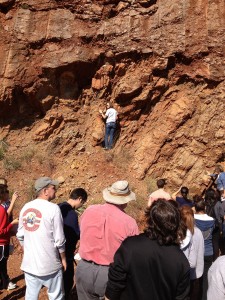By Karen Gavis/managing editor

Karen Gavis/The Collegian
About 50 NE Campus geology students awoke early Oct. 20 and boarded a charter bus bound for Oklahoma on an expedition to study the earth.
The group, accompanied by five rock-hammer-bearing geology faculty members, gathered at 7 a.m. for a field trip destined for the Arbuckle Mountains. Half a dozen others waited, hoping to snag a seat if there were no-shows. All, including a boyfriend, boarded.
That morning, the party examined layers of rocks at several areas along Interstate 35.
“This is a lot better than the textbook,” one student said after disembarking.
At the Arbuckle Anticline, instructor Teresa Teague slid eagerly down an embankment, and instructor Steven Terry leaned his cell phone against one rock to measure its strike and slope. Some students chiseled away at rocks while others contemplated climbing them, gaining courage after watching the successful attempts of a few others.
“About 10 years ago, this was all covered in brush,” instructor Dennis Gleason said, referring to the landscape, which burned and now is dotted with occasional patches of petite yellow wildflowers.
Wearing an “I dig dinos” T-shirt, NE geology major Jeremy Greene closely inspected chunks of red earth from the Collins Ranch Conglomerate.
“The workings of the earth have always fascinated me,” he said. “It fascinates me more than working on cars.”
Greene said people can read about geology all day in books but will never really understand it until they get their hands on it.
“It is the only planet we’ve got,” he said. “We need to understand it to take care of it.”
Back on the bus, scenes of cattle, vintage gas stations, fence rows, hay bales, armadillo corpses and occasional drilling rigs whizzed past while discussion topics veered to maps, igneous rocks and chigger attacks.
“Turner Falls here!” instructor David Sallee said, one arm springing up and to the right as the bus was passing the exit.
The falls are Oklahoma’s highest waterfall. Sallee said the falls are similar to a cave formation, and upon arrival, he warned students of slippery rocks and rattlesnakes.
“I wouldn’t get too far off trail,” he said. “That’s number one.”
At another stop, students were offered plastic bags and scooped fine-grain, white, ancient beach sand near a silica quarry. The sand, formed about 465 million years ago, is considered some of the purest on earth, primarily because it existed prior to life on land, Terry said.
One NE student who had never visited a beach said she was unfamiliar with beach sand. She plans to go on an upcoming geology trip to Hawaii, where she will also experience black sand.
The group lunched at the Chickasaw National Recreation Area, where one NE student had her first view of horse apples bobbing in the stream. Afterward, they strolled over to an artesian spring and well.
Several students commented on the well’s rotten egg smell while others bravely, and some reluctantly, tasted the foul-smelling mineral water.
“It tastes like it smells — horrible,” NE student Joshua Williams said.
Donning a khaki safari-style hat, instructor Dennis Gleason lectured from atop a barrier that circled the artesian well. Gleason later explained that artesian simply means the water flows naturally to the surface by itself.
At Ten Acre Rock, professor Meena Balakrishnan handed one student a sage specimen before her ascension.
“Watch your step,” she said.
Sallee said Ten Acre Rock is habitat to the Ten Acre grasshopper. Other living things such as lichen, moss and assorted sparsely scattered sprigs also make the sprawling rock their home.
“It [lichen] is one of the first things that can colonize the bare rock,” Teague said.
The last stop on the adventure was Tishomingo, where some students visited a 1902 structure made from Tishomingo granite that once housed the Bank of the Chickasaw Nation.
Although it was closing time, members of the Johnston County Historical Society, who now own the building, welcomed the budding earth scientists inside for an interior view of the Wild West-era former bank.
Back on the bus and headed home, Sallee displayed a rock specimen whose identity, for the moment, eluded both him and Gleason.
“I don’t know,” he said tossing it into his take-home pile.
